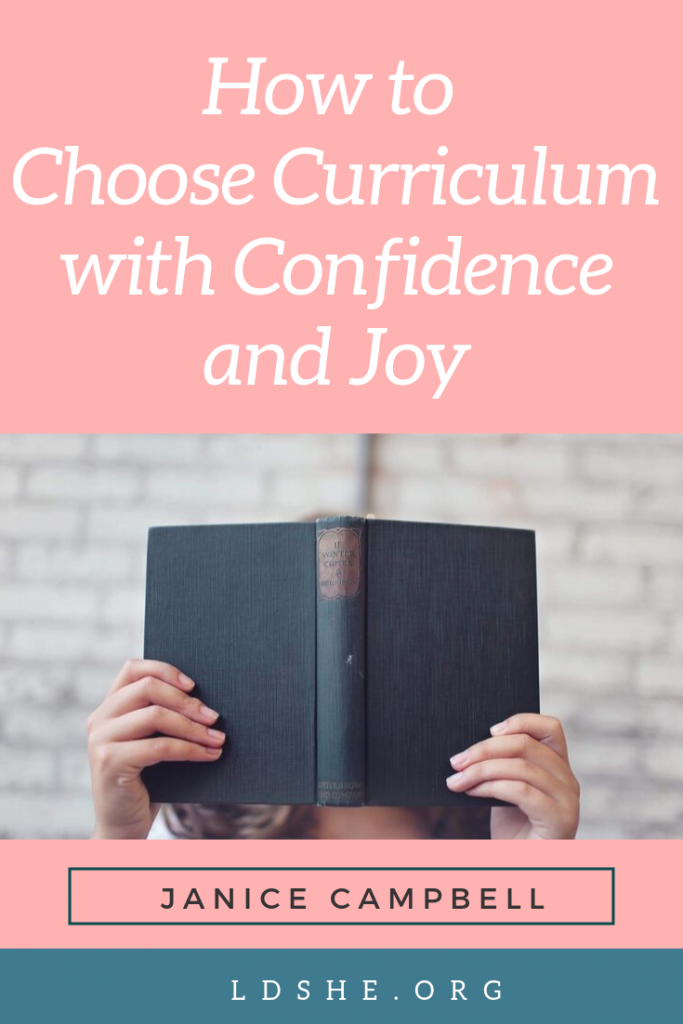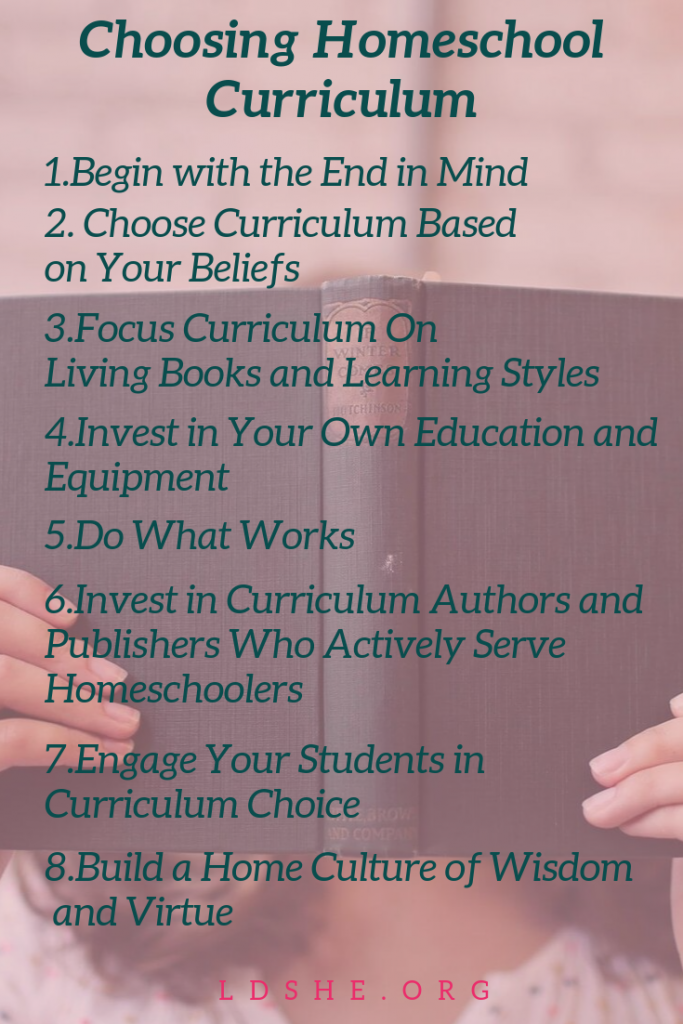How do you make wise curriculum choices for your family? What are the most important things to consider? And what should you do if something does not work as you thought it would?
When I was a homeschool mom, our state’s annual homeschool convention was the highlight of my school year. Not only was it a romantic weekend getaway with my husband (thanks to my sweet in-laws). It was also an opportunity to spend time looking at all the new curricula that was available. And time to talk to authors, publishers, and vendors who had used it.
Since my boys graduated, curriculum options have continued to proliferate. To the point that exploring a convention hall can be overwhelming. No matter what you are looking for, there are seven principles that will help you make wise choices for your family.

1. Begin with the End in Mind
It’s incredibly easy to get caught up in an activity trap, in the busy-ness of life, to work harder and harder at climbing the latter of success only to discover it’s leaning against the wrong wall. ~ Stephen Covey
In 7 Habits of Highly Effective People, Stephen Covey reminds readers to begin any task with the desired result in mind. What do you want to accomplish through homeschooling your children? You may have several important ends in mind. Before you choose curriculum, it is important to sort them out and know which is essential, and which is desirable.
Goals
For example, you may have some of the following goal areas for your students:
- Personal relationship with God
- Learn how to read fluently
- Memorize the fifty states and their capitals
- Strong family relationships
- Memorize the multiplication tables and order of operations
- Grow in wisdom and virtue
- Know how to maintain a vehicle
- Equip your student for his/her calling
Choose Curriculum Based on Your Beliefs
As you consider this list and make your own additions to it, you can see that the items listed differ in magnitude of importance. There are things that matter for time, and things that matter for eternity. Eternal things are essential, while skills and knowledge are good and desirable.
How can you choose resources that will help you teach the desirable things in a way that does not detract from the most essential things? I believe that the first step is to understand the basic educational philosophies that underlie curriculum and teaching methods.
Perennialism
Ideas and principles are the basis of this classic education philosophy. Which focuses on providing students, seen as created beings with intrinsic value; with tools of thought and a deep understanding of truth through the seven liberal arts. In the words of John Henry Newman, “Truth of whatever kind is the proper object of the intellect; its cultivation then lies in fitting it to apprehend and contemplate truth. ” This philosophy, with its goal of cultivating wisdom and virtue, was the guiding educational philosophy until the late nineteenth century.
Essentialism
This subject-oriented philosophy, first articulated in the early twentieth century and sometimes referred to as “back to basics;” is focused on covering a checklist of subjects. Principally those thought to be essential for developing good, productive citizens. Unlike Plutarch, who believed that “education is not the filling of a pail, but the lighting of a fire;” essentialists tend to be pail-fillers. With the belief that education is teacher centered; and the goal of education is to cover subjects, rather than to seek truth or inspire students.
Progressivism
Pragmatism and utilitarianism are the focus of progressive education. John Dewey, the most prominent proponent of progressivism, believed “education is the fundamental method of social progress and reform.” And the teacher is “a social servant set apart for the maintenance of proper social order and the securing of the right social growth.” (Dewey, My Pedagogic Creed, Article 5). The progressivist movement reflects Dewey’s personal atheistic, humanistic, and relativistic beliefs; and along with essentialism, is the dominant philosophy behind modern education.
Armed with a basic understanding of educational philosophy; you can look for curriculum that closely aligns with your worldview and values. For a Christian, a curriculum with a Christian worldview is more important than a curriculum with Christian content. It is fairly simple for a publisher to add a few Bible verses to a curriculum and call it Christian; but if that curriculum is based on essentialist ideals, students are unlikely to emerge with a truly Christian worldview.
2.Focus Curriculum On Living Books and Learning Styles
Children must be nurtured on the best . . . Let Blake’s ‘Songs of Innocence’ represent their standard in poetry; DeFoe and Stevenson, in prose; and we shall train a race of readers who will demand literature–that is, the fit and beautiful expression of inspiring ideas and pictures of life. ~ Charlotte Mason, Parents and Children
Curriculum can seem expensive, but be sure to consider the long-term value of each purchase. Living books, including biographies, fiction, and nonfiction; can be read and enjoyed across multiple grades and ages, while age-graded textbooks and workbooks have limited use. In the same way, ungraded audio and video resources, such as musical math facts, audiobooks, ungraded foreign language resources, or science or art videos can be used again and again.
Consider devoting a portion of your curriculum budget to reference resources. Including a good dictionary, thesaurus, writer’s handbook, math dictionary, history encyclopedia, atlas, and globe. To these, add art supplies and musical instruments, balls and play equipment. As well as tools for building, cooking, fixing, crafting, and gardening. This investment in non-graded, real-life-oriented resources creates a rich learning environment that can encourage a love of learning; develop individual skills and talents, and orient the soul toward truth, beauty, and virtue.
3. Invest in Your Own Education and Equipment
The fear of the LORD is the beginning of wisdom, and knowledge of the Holy One is understanding. ~ Proverbs 9:10
If you were planning a month-long road trip; you would be wise to invest in a map to get a birds-eye view of your route; read some guidebooks to learn details about what you might need or want to do; and talk to others who have taken the road you are considering. In the same way, it makes sense to equip yourself for the homeschool journey.
Books
For your homeschooling roadmap, you may want to begin with a few good education books. Such as For the Children’s Sake by Susan Schaeffer Macauley; Educating the Whole Hearted Child by Clay and Sally Clarkson; and A Thomas Jefferson Education by Oliver DeMille.
Read these books thoroughly, then subscribe to at least one homeschool magazine. Read each issue from cover to cover. Including the advertisements; mark articles and resources that seem to fit your educational philosophy and worldviews; as well as your students’ learning styles. Visit the blogs and websites of article authors you find interesting, and sign up for their e-newsletters.
Catalogs
Finally, request catalogs from publishers that interest you. Visit their websites and blogs and learn about their educational philosophies and the worldview of their materials. Join a local support group and one or two online groups so that you can share the journey with others. There are many good groups on Facebook and Yahoo where you can ask questions; read about the experiences of others; and even buy and sell used curriculum.
As your budget permits, equip your home with things that streamline daily tasks. Make your home more beautiful and efficient. This may include more bookshelves and storage units; kitchen tools that ease your tasks; a good sound system for listening to audiobooks throughout the home; or a larger dining room table so that you and your students can spread out to work.
4. Do What Works
“Progress means getting nearer to the place you want to be. And if you have taken a wrong turning, then to go forward does not get you any nearer. If you are on the wrong road, progress means doing an about-turn and walking back to the right road; and in that case the man who turns back soonest is the most progressive man.” ~ C.S. Lewis, Mere Christianity
As you make curriculum decisions year after year; you are certain to purchase materials that do not work well for your family. They may unsuitable due to educational philosophy; your students’ learning styles; or life circumstances or events that make it impossible to use them as needed. When this happens, consider it a part of your teacher education, and make whatever change is needed.
If It isn’t Working
If you like the material but it is too difficult, set it aside for later. Too elementary? Sell it or give it away. When you find it’s making your student hate a previously loved subject, get rid of it immediately. Anything complicated that it eats up your whole day, simplify it or pass it on. If just looking at it makes you queasy, get rid of it. If it is ruining relationships in your family, set it aside and seek counsel from a wise older homeschool mom. They may be able to provide insight as to what you can do.
Never feel guilty about not continuing on a road that is going in the wrong direction. When you begin with the end in mind, finding that is not leading you where you need to go; simply release it so that it can bless someone for whom it is more suitable. Whether you give it away or sell it; the time and money spent are part of your education; and certainly not wasted, as long as you do not keep doing something that does not work.

5. Invest in Curriculum Authors and Publishers Who Actively Serve Homeschoolers
For the scripture says, you shall not muzzle the ox that treads out the grain. And, the laborer is worthy of his reward. ~ I Timothy 5:18
When our family began homeschooling in the late 1980s, there were very few homeschool resources. Over the past few decades, the two eight-foot curriculum tables I saw at my first homeschool convention have multiplied exponentially; and homeschool families are blessed with an increasing array of curriculum choices. Every year, new books and programs roll out; and larger and more professional publishers seek to cash in on the homeschool market.
Small Companies
Keep in mind that although big publishers may have slicker covers, flashier advertisements, and sometimes-cheaper prices than smaller homeschool-focused publishers; they may have little or no practical homeschool experience. And may not be able to answer questions or provide genuine help in choosing materials. The very best homeschooling materials are often written and produced by homeschooling families. Families who understand what it is like to teach Latin or literature with a toddler clinging to one leg; and a basket of laundry balanced on your hip.
Spend time in the vendor hall at your next homeschool convention. Ttalk to the authors, speakers, and small publishers you meet there. Remember that for these individuals and small companies, it is a major investment of time and money to be there. Most are there because they have been called to serve homeschool families in this way. They spend countless hours answering questions, providing recommendations, and calming the fears of anxious parents. Purchasing curriculum directly from them, rather than from big discount retailers; can help them remain in business and be able to continue their ministry.
6. Engage Your Students in Curriculum Choices
Getting things done is not always what is most important. There is value in allowing others to learn, even if the task is not accomplished as quickly, efficiently or effectively. ~ R.D. Clyde
As your students’ interests, talents, and learning styles become more apparent; it can be a good idea to take them to curriculum fairs. Allow them to help choose the curricula they will be using. This can be especially helpful if your learning style or interests differ significantly from your student’s. You will tend to be drawn toward materials you would enjoy or find effective; and they may be completely wrong for your student. As a visual learner, I did not find audio or manipulative-based resources appealing or helpful; but my auditory and kinesthetic learners needed them. In addition, my boys tended to be more engaged with materials they helped to choose.
7. Build a Home Culture of Wisdom and Virtue
But the fruit of the Spirit is love, joy, peace, longsuffering, kindness, goodness, faithfulness, gentleness, self-control. Against such there is no law. ~ Galatians 5:22–23
Although it is important to choose curriculum that fits your family; it is far more important to build a home culture of wisdom and virtue. We are not called to teach our students all they need to know for life. Rather we are called to establish a foundation on which they can build.
Your children are likely to adopt the attitudes, values, and worldviews they see in your home. So it is important that you continually seek to grow in grace, knowledge, and gratitude. Cultivate the fruit of the spirit, first in yourself, then in your students; and you will have chosen the best curriculum of all.


